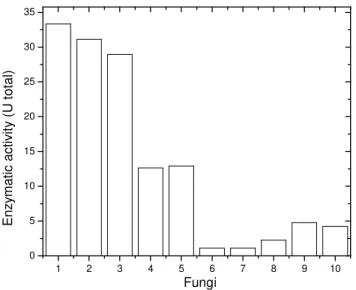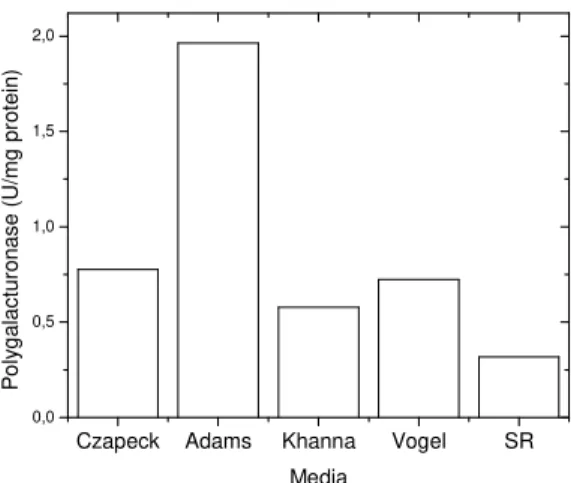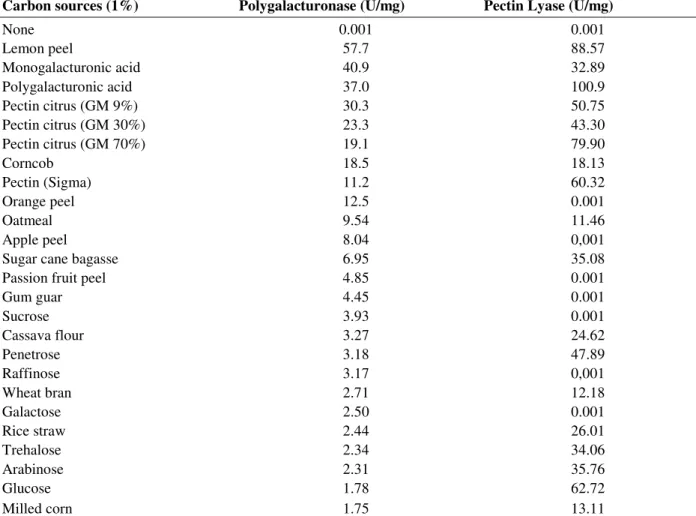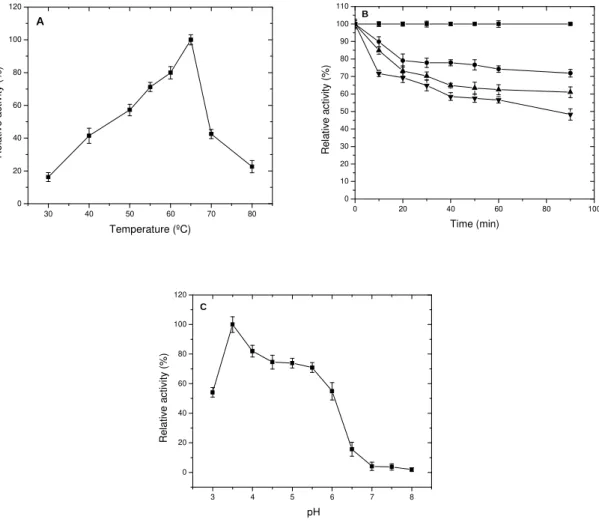Vol.54, n. 1: pp. 141-148, January-February 2011
ISSN 1516-8913 Printed in Brazil BRAZILIAN ARCHIVES OF
BIOLOGY AND TECHNOLOGY A N I N T E R N A T I O N A L J O U R N A L
Biotechnological Potential of Alternative Carbon Sources for
Production of Pectinases by
Rhizopus microsporus
var.
rhizopodiformis
André Ricardo de Lima Damásio
1, Alexandre Maller
1, Tony Márcio da Silva
2, João Atílio
Jorge
2, Hector Francisco Terenzi
2and Maria de Lourdes Teixeira de Moraes Polizeli
2*1Departamento de Bioquímica e Imunologia; Faculdade de Medicina de Ribeirão Preto; Universidade de São
Paulo; Av. Bandeirantes, 3900; 14040-901; Ribeirão Preto - SP - Brasil. 2Departamento de Biologia; Universidade de São Paulo; Av. Bandeirantes, 3900; 14040-901; Ribeirão Preto - SP - Brasil
ABSTRACT
Fungicollected from Brazilian soil and decomposing plants were screened for pectinase production. R. microsporus
var. rhizopodiformis was the best producer and was selected to evaluate the pectic enzyme production under several nutritional and environmental conditions. The pectinase production was studied at 40ºC, under 28 carbon sources-supplemented medium. The inducer effect of several agro-industrial residues such as sugar cane bagasse, wheat flour and corncob on polygalacturonase (PG) activity was 4-, 3- and 2-fold higher than the control (pectin). In glucose-medium, a constitutive pectin lyase (PL) activity was detected. The results demonstrated that R. microsporus produced high levels of PG (57.7 U/mg) and PL (88.6 U/mg) in lemon peel-medium. PG had optimum temperature at 65 ºC and was totally stable at 55 ºC for 90 min. Half-life at 70 ºC was 68 min. These results suggested that the versatility of waste carbon sources utilization by R. microsporus, produce pectic enzymes, which could be useful to reduce production costs and environmental impacts related to the waste disposal.
Key words: agro industrial residues, lemon peel, pectin lyase, polygalacturonase, R. microsporus var.
rhizopodiformis
*Author for correspondence: polizeli@ffclrp.usp.br
INTRODUCTION
Celluloses, hemicelluloses and pectic substances are the most abundant carbohydrates present in the plant cell walls. Pectic substances such as pectin, protopectin and pectic acids are present in the middle lamella and contribute to firmness and structure to the plant tissues. In the pectic substances, D-galacturonic acid units are linked by α-1,4 – glycosidic linkages and the carbonyl side
groups are 60 – 90% esterified with methanol (Gummadi and Panda, 2003).
PG (EC 3.2.1.15) is a depolymerizing pectinase that catalyzes the hydrolysis of α-(1,4) glycosidic bounds between the non-esterified galacturonic acid units (Mohamed et al., 2006). Pectate lyase (EC 4.2.2.2) and PL (EC 4.2.10.10) cleave α -1,4-glycosidic linkages by trans-elimination, which results in galacturonide with an unsaturated bond between C4 and C5 at the non-reducing end of the galacturonic acid formed.
Pectinases can be used in several industrial processes as fruit juices and wine production, tea and coffee fermentation or olive oil recovery, vegetable oil extraction, functional foods, improvement of cassava starch extraction, textile industry, paper and cellulose industry and animal feeds (Gummadi and Panda, 2003). Pectinases have also been used in the paper and pulp industry in addition to cellulases (Reid and Ricard, 2000), due to its presence in the plant host microorganisms (Hershonhorn et al., 1990; Lang and and Dornenburg, 2000).
Brazil has a prominent role in the production and exportation of coffee, sugar cane, soybean, fruit and other products. However, industrial processing of these items results in the generation of huge amount of other materials. Some applications suggested for these residues are their utilization as substrates for microbial fermentation bioprocesses, to obtain valuable products, such as enzymes, alcohol, proteins, organic acids, amino acids, bioactive and flavour compounds (Medeiros et al., 2000).
The Tahiti lemon is a fruit of tropical origin, with recent economic exploration. In the world context, the main producers are Mexico, USA, Egypt, India, Turkey and Brazil. The “albedo", which corresponds the spongy portion, white and adherent to the peel, is rich in hemicellulose, cellulose, pectic substances, soluble carbohydrate, lignin and phenolic compounds (Ros et al., 1996). The aim of this work was to select the fungi from the soil or decomposing plants, with the components for good production of pectinases and to evaluate the effects of several carbon sources and environmental conditions on fungal pectinase production by the selected strains.
MATERIALS AND METHODS
Organisms and maintenance
Ten fungi were isolated from the soil and plants waste from different areas of São Paulo and
Paraná states, Brazil, as previously cited by Guimarães et al. (2006) and these were cultivated on PDA medium at 40ºC. The investigated areas were located at S 21º09.190’ – 45º52.150’W, in the municipality of Ribeirão Preto, SP (Aspergillus phoenicis, A. ochraceus, Mucor rouxii, Humicola
grisea var. thermoidea and Scytalidium
thermophilum); S 20º25.896’ – 51º20.681’W, in
the municipality of Ilha Solteira, SP (A.
caespitosus and P. variotii); S 21º55.626’ –
47º28.109’W, in the municipality of Pirassununga, SP (Rhizopus microsporus var. rhizopodiformis); S 24º57’21’’ – 53º27’19’’W in the municipality of Cascavel, PR (Penicillium herquei). The fungi were inoculated in Czapeck medium at 40°C with agitation (100 rpm) for three days to screen pectinases production. Rhizopus microsporus var.
rhizopodiformis was selected as the best pectinase
producer among the isolated fungi. The fungus was identified by André Tosello Foundation, Campinas, SP, (OS 990300) according to Schipper and Stalpers (1984).
Growth conditions
For the production of PG the submerged fermentation (SmF) of approximately 3x105 spores/ml from 15-day-old cultures were inoculated into 125 ml Erlenmeyer flasks containing 25 ml of Adams medium (Adams, 1990) with 1.0% citric pectin (w/v) or other carbon sources, (monogalacturonic acid, polygalacturonic acid, corncob, orange peel, lemon peel, oatmeal, apple peel, sugar cane bagasse, passion fruit peel, gum guar, sucrose, cassava flour, penetrose, raffinose, wheat bran, galactose, rice straw, trehalose, arabinose, glucose and milled corn). The cultures were incubated at 40°C with agitation (100 rpm) for five days. Other liquid media compositions were also tested which included Khanna (Khanna et al., 1995), SR (Rizzatti et al., 2001), Czapeck (Wiseman, 1975) and Vogel (Vogel, 1964).
Preparation of crude enzyme
The culture filtrates were obtained by filtration through Whatman No. 1 paper in a Buchner funnel. The filtrate was saved as a source of crude extracellular PG. The mycelial mass was ground with glass beads at 4ºC.
Enzymatic assays and protein determination
65ºC (temperature optimum – see results), in a reaction mixture containing 0.25 ml of enzyme and 0.25 ml of 1.0% sodium polypectate in 100mM sodium acetate buffer, pH 3.5 (pH optimum – see results). One unit was defined as the amount of enzyme that released one µmol of reducing sugar per minute under the assay conditions. PL activity was assayed according to Pitt (1988). One unit was defined as the amount of enzyme that changed the absorbance of 0.01 at 550 nm under the assay conditions. Pectate lyase activity was assayed according to Collmer and Ried, (1988). One unit was defined as the amount of enzyme that released one mol of unsaturated digalacturonate per minute under the assay conditions. The growth was estimated as protein of the mycelial extract (total mg), according to Lowry et al.(1951) using bovine serum albumin as standard.
Effects of temperature and pH
The crude extract obtained from the lemon peel as carbon source was used to evaluate the PG activity as a function of pH in McIlvaine buffer (pH 3.0-8.0) at 65ºC with 1% sodium polypectate (NaPP) as substrate. The effect of temperature on PG activity was analysed in McIlvaine buffer incubated between 30 and 80ºC at the optimum
pH. The thermal stability was investigated by measuring the residual activity of the enzyme after 90 min of incubation at 30-80ºC.
Reproducibility of the results
All data are the mean of at least three independent experiments showing consistent results.
RESULTS
Fungi are interesting enzyme sources for biotechnological application. Among the various filamentous fungi collected (maintained at 40°C in the plates with 4% solid oatmeal medium) (Fig. 1),
Rhizopus microsporus var. rhizopodiformis
produced the highest PG levels. There was no report in the literature about this thermotolerant strain as a PG producer. This fungus is a thermotolerant fungus, identified and deposited in the André Tosello Foundation (Brazil). The fungus was cultivated in five different media for pectinase production under agitation (100 rpm) for five days at 40ºC. The enzymes were assayed in the culture filtrate. The best enzymatic yields were obtained in Adams medium (Fig. 2).
Figure 1 - Pectinases screening. 1) Rhizopus microsporus var. rhizopodiformis; 2) Penicillium
herquei; 3) Aspergillus caespitosus; 4) Aspergillus phoenicis; 5) Aspergillus ochraceus; 6) Paecilomyces variotii; 7) Humicola insolens; 8) Humicola grisea var. thermoidea; 9) Mucor rouxii; 10) Scytalidium thermophilum. The fungi were inoculated in Czapeck medium, at 40°C, with agitation (100 rpm) for 3 days.
1 2 3 4 5 6 7 8 9 10
0 5 10 15 20 25 30 35
E
nz
y
m
a
ti
c
ac
ti
v
it
y
(
U
t
ot
al
)
Figure 2 - Production polygalacturonase by R. microsporus var. rhizopodiformis in different culture media.
Time-course of pectinases production
The fungus was inoculated in Adams medium supplemented with 1% (w/v) Sigma citric pectin as carbon source. The maximun PG production was after 72 h (Fig. 3A), (also the highest amount of micelial mass) (Fig. 3B). A decrease in
enzymatic synthesis occurred after 72 h, probably due to the inhibition of the enzyme by the end-products. The highest PL production was detected after 48 h of culture. Pectate lyase levels were only detected after 120 h.
40 50 60 70 80 90 100 110 120 130
0 20 40 60 80 100 120 140
A
E
n
z
y
m
a
ti
c
a
c
ti
v
it
y
(
U
/m
L
)
Time (h)
polygalacturonase pectate lyase pectin lyase
Figure 3 - Time course of pectinases production (A) and growth of the microorganism (B) in
cultures under agitation (100 rpm).
Effect of carbon sources on pectinases production
Polygalacturonase
Table 1 shows the influence of carbon sources on
the R. microsporus var. rhizopodiformis PG
production, cultivated for 72 h at 40ºC under agitation (100 rpm) in Adams medium. The most effective inducer carbon source was lemon peel, increasing up to 5-fold the PG production compared with 1% Sigma pectin (control). Under glucose addition, some constitutive PG synthesis
was detected, with low activity levels, close to those observed in the absence of additional carbon sources. For the pectins with different methylation degrees, PG production was higher than the control and the extent of enzyme production decreased with an increase in the degree of esterification.
Pectin lyase
Several carbon sources were tested for PL induction (Table 1). The highest activity was Czapeck Adams Khanna Vogel SR
0,0 0,5 1,0 1,5 2,0
P
o
ly
g
a
la
ct
u
ro
n
a
se
(
U
/m
g
p
ro
te
in
)
Media
24 48 72 96 120
0,00 0,05 0,10 0,15 0,20 0,25 0,30
B
G
ro
w
th
(
g
)
found for polygalacturonic acid and lemon peel-supplemented cultures. In the presence of glucose, a constitutive PL activity was observed. In the absence of a carbon source no enzymatic activity was detected.
Effect of temperature and pH on polygalacturonase activity
The optimum temperature and pH for PG activity
were 65ºC and 3.5, respectively (Figs. 4A and C). The thermostability assay (Fig. 4B) was carried out with the extract incubated at 55, 60, 65 and 70ºC, for 90 min under the absence of the substrate and after that the enzymatic assays were carried out. The enzymatic activity decreased about 28 and 39% at 60 and 65ºC, respectively. At 70ºC it was possible to calculate the t50 (68 min.), which showed a reduction of 50% in the PG activity.
Table 1 - Effect of different carbon sources on the production of polygalacturonase and pectin lyase by R.
microsporus var. rhizopodiformis.
Carbon sources (1%) Polygalacturonase (U/mg) Pectin Lyase (U/mg)
None 0.001 0.001
Lemon peel 57.7 88.57
Monogalacturonic acid 40.9 32.89
Polygalacturonic acid 37.0 100.9
Pectin citrus (GM 9%) 30.3 50.75
Pectin citrus (GM 30%) 23.3 43.30
Pectin citrus (GM 70%) 19.1 79.90
Corncob 18.5 18.13
Pectin (Sigma) 11.2 60.32
Orange peel 12.5 0.001
Oatmeal 9.54 11.46
Apple peel 8.04 0,001
Sugar cane bagasse 6.95 35.08
Passion fruit peel 4.85 0.001
Gum guar 4.45 0.001
Sucrose 3.93 0.001
Cassava flour 3.27 24.62
Penetrose 3.18 47.89
Raffinose 3.17 0,001
Wheat bran 2.71 12.18
Galactose 2.50 0.001
Rice straw 2.44 26.01
Trehalose 2.34 34.06
Arabinose 2.31 35.76
Glucose 1.78 62.72
Milled corn 1.75 13.11
a
None: Adams medium without sugar or agro industrial residues addition..
DISCUSSION
This study evaluated the environmental and nutritional influence on pectinase production by R.
microsporus var. rhizopodiformis, cultivated in
submerged culture. Adams medium showed the best composition for the fungus growth and enzyme production. Other media also supported significant enzymatic yield. For example, potato-dextrose liquid medium plus 0.1% citric pectin for
Trichoderma harzianum (Mohamed et al., 2006),
or Kebede medium for Kluyveromyces
wickerhamii (Moyo et al., 2003).
var. rhizopodiformis showed a good adaptation in Adams medium. The logarithmic phase was well-defined; it started around 24 h and finished at around 48 h. Talaromyces flavus pectic enzyme
production was also maximum in 48 h (Crotti et al., 1999) in Manachini medium (Manachini et al., 1988) supplemented with 0.8% (w/v) pectin at 30ºC under constant agitation.
Figure 4 - Influence of temperature (A and B) and pH (C) on polygalacturonase activity.
Determination of optimum temperature (A) was carried out at pH 3.5. Thermal inactivation (B) was carried out at 55ºC ( ), 60°C ( ), 65°C ( ) or at 70°C ( ). The assay of determination of optimum pH (C) was carried out at 65ºC.The polygalacturonase activity was estimated by the DNS method using sodium pectate as substrate.
The agro industrial residues used for the enzyme production represent an economic alternative for the carbon sources and also contribute to decrease the pollution concern about waste accumulation in the environment, therefore they have been frequently studied (Martin et al., 2004). Lemon peel was an interesting carbon source for PG production. Ros et al.(1996) worked with different variety of pectic substances from the lemon “albedo” cell walls, where alcohol insoluble
solids were extracted to obtain a chelating agent soluble pectin fraction (ChSS), a diluted sodium hydroxide soluble pectin fraction (ASS) which was separated into a water soluble and water insoluble part (ASSws and ASSwi), and an insoluble residue (Residue). ChSS, ASSws, ASSwi and residue represented 64.3, 10.4, 0.4 and 8.1% of the galacturonic acid residues present in the lemon “albedo”, respectively.
30 40 50 60 70 80
0 20 40 60 80 100 120
A
R
e
la
ti
v
e
a
c
ti
v
it
y
(
%
)
Temperature (ºC)
0 20 40 60 80 100
0 10 20 30 40 50 60 70 80 90 100 110
B
R
e
la
ti
v
e
a
c
ti
v
it
y
(
%
)
Time (min)
3 4 5 6 7 8
0 20 40 60 80 100 120
C
R
e
la
ti
v
e
a
c
ti
v
it
y
(
%
)
A marked feature of the lemon “albedo” is the exceptionally high level of pectin throughout the cell walls from early on fruit development (Bain, 1958). They found that over 25% of the CWM (Cell Wall Material) of the immature lemon “albedo” consisted of galacturonic acid, the main constituent of pectin. Although the yield of CWM decreased during the maturation this level of galacturonic acid is maintained until the fruit is ripe. The non-cellulosic monosaccharide composition of cell wall material isolated from lemon “albedo” was 3.4 mol % rhamnose, 1.1 mol % fucose, 29.2 mol % arabinose, 5.2 mol % xilose, 2.1 mol % mannose, 16.5 mol % galactose, 4.1 mol % (glucose) and 38.5 mol % galacturonic acid (Ros et al., 1988).
R. microsporus var. rhizopodiformis produced PG,
which exhibited an optimum temperature (65ºC) suitable for future biotechnological applications. Mohamed et al. (2006), reported a T. harzianum
PG with optimum temperature at 40ºC, which retained 30% of its activity at 60ºC. The optimum temperature for PG from Bacillus sp. (Kobayashi et al., 2001) and T. reesei (Mohamed et al., 2003) were around 40 and 50ºC, respectively. Channe and Shewal (1995) studied a PG from Sclerotium
rolfsii with optimum temperature at 55ºC. The
enzymatic activity decreased 28, 39 and 51% after incubation for 90 min at 60, 65 and 70ºC, respectively. The thermal inactivation of the T.
harzianum (Mohamed et al., 2006) PG was
investigated by incubating the enzyme for 15, 30 and 60 min, at 10 to 100ºC in the absence of substrate. The PG from T. reesei was stable at 40 and 50ºC (Mohamed et al., 2003).
The present work showed that agro industrial wastes, especially, lemon peel, improved the PG and PL production by the thermotolerant fungus R.
microsporus var. rhizopodiformis. The agro
industrial residues used for the enzyme production represent alternative carbon sources, and also contribute to decrease the pollution concern about waste accumulation in the environment. These alternative carbon sources might reduce the enzyme production costs too.
ACKNOWLEDGEMENTS
This work was supported by the grants from Fundação de Amparo à Pesquisa do Estado de São Paulo (FAPESP) and Conselho de Desenvolvimento Científico e Tecnológico (CNPq). H. F. T.; J. A. J.; M. L. T. M. P. are Research Fellows of CNPq. A.R.L.D.; A.M; T.M.S. are recipient of the FAPESP Fellowship. We thank Ricardo Alarcon and Mauricio de Oliveira for technical assistance.
REFERENCES
Adams, P.R. (1990), Mycelial amylase activities of thermophilic species of Rhizomucor, Humicola and
Papulaspora, Mycopathol., 12, 35-37.
Bain, J.M. (1958), Morphological, anatomical, and physiological changes in the developing fruit of the Valencia orange, Citrus sinensis (L.), Osbeck. Austr. J. Bot., 6, 1–24.
Blandino, A., Dravillas, K., Cantero, D., Pandiella, S. S., Webb, C. (2001), Utilisation of whole wheat flour for the production of extracellular pectinases by some fungal strains, Process Biochem., 37, 497-503. Channe, P.S., Shewal, J.G. (1995), Pectinase production
by Sclerotium rolfsii: Effect of culture conditions,
FoliaMicrobiol., 40, 111-117.
Collmer, A., Ried, J.L., Mount, M.S. (1988), Assay methods for pectic enzymes, Meth. Enzymol., 161, 326-335.
Crotti, L.B., Jabor, V.A., Chellegatti, M.A., Fonseca, M.J., Said, S. (1999), Studies of pectic enzymes produced by Talaromyces flavus in submerged and solid substrate cultures, J. BasicMicrobiol.,39, 227-235.
Guimarães, L.H., Peixoto-Nogueira, S.C., Michelin, M., Rizzatti, A.C.S, Sandrim, V.C., Zanoelo, F.F., Aquino, A.C.M.M, Junior, A.B., Polizeli, M.L.T.M. (2006), Screening of filamentous fungi for production of enzymes of biotechnological interest, Braz. J. Microbiol.,37, 474-480.
Gummadi, S.N., Panda, T. (2003), Purification and biochemical properties of microbial pectinases – a review, ProcessBiochem.,38, 987-996.
Hershonhorn, J., Manulis, S., Barash, I. (1990), Polygalacturonase associated with infection of Valencia orange by Penicillium italicum,
Khanna, P., Sundari, S.S., Kumar, N.J. (1995), Production, isolation and partial purification of xylanase from Aspergillus sp, World J. Microbiol. Biotechnol.,11, 242-243.
Kobayashi, T., Higaki, N., Suzumatsu, A., Sawada, K., Hagihara, H., Kawai, S., Ito, S. (2001), Purification and properties of a high molecular-weight,alkaline exopolygalacturonase from strain of Bacillus, Enzyme Microb. Technol.,29, 70–75.
Lang, C., Dornenburg, H. (2000), Perspectives in the biological function and the technological application of polygalacturonases, Appl. Microbiol. Biotechnol., 53, 366-375.
Lowry, H., Rosebrough, N.J., Farr, A.L., Randal, R.J. (1951), Protein measurement with the Folin phenol regent, J. Biol. Chem.,193, 267-275.
Malvessi, E., Silveira, M. M. (2004), Influence of medium composition and pH on the production of polygalacturonase by Aspergillus oryzae, Braz. Arch. Biol. Technol., 47, 693-702.
Manachini, P.L., Parini, C., Fortina, M.G. (1988), Pectic enzymes from Aureobasidium pullulans
L.V.10, Enzyme Microb. Technol., 10, 682-685. Martin, N., Souza, S. R., Silva, R., Gomes, E. (2004),
Pectinase production by fungal strains in solid-state fermentation using agro-industrial bioproduct, Braz. Arch. Biol. Technol., 47, 813-819.
Medeiros, A.B.P., Pandey, A., Freitas, R.J.S, Christen, P., Soccol, C.R. (2000), Optimization of the production of aroma compounds by Kluyveromyces marxianus in solid-state fermentation using factorial design and response surface methodology, Biochem. Eng. J.,6, 33-39.
Miller, G.L. (1959), Use of Dinitrosalicylic Acid reagent for determination of reducing sugar, Anal. Chem.,31, 426 – 429.
Mohamed, S.A., Christensen, T.M.I.E, Mikkelsen, J.D. (2003), New polygalacturonases from Trichoderma reesei: characterization and their specificities to partially methylated and acetylated pectins,
Carbohydr. Res.,338, 515–524.
Mohamed, S.A., Farid, N.M., Hossiny, E.N., Bassuiny, R.I. (2006), Biochemical characterization of an extracellular polygalacturonase from Trichoderma harzianum, J. Biotechnol.,127, 54-64.
Moyo, S., Gashe, B.A., Collison, E.K., Mpuchane, S. (2003), Optimising growth conditions for the pectinolytic activity of Kluyveromyces wickerhamii
by using response surface methodology, Int. J. Food Microbiol.,85, 87– 100.
Pitt, M. (1988), Pectin lyase from Phoma medicaginis
var. pinodella, Methods Enzymol.,161, 350-354. Reid, I., Ricard, M. (2000), Pectinase in papermaking
solving retention problems in mechanical pulps bleached with hydrogen peroxide, Enzyme Microb. Technol.,26, 115-123.
Rexová-Benková, L., Markovic, O. (1976), Pectic enzymes: Advances in Carbohydrate Chemistry and Biochemistry, Academic Press, NewYork, USA, pp. 323–385.
Rizzatti, A.C.S., Jorge, J.A., Terenzi, H.F., Rechia, C.G.V., Polizeli, M.L.T.M. (2001), Purification and properties of a thermostable extracellular β -D-xylosidase produced by thermotolerant Aspergillus phoenicis, J. Ind. Microbiol. Biotechnol. 26, 156-160. Ros, J.M., Schols, H., Voragen, A.G.J. (1988), Lemon
albedo cell walls contain distinct populations of pectic hairy regions, Carbohydr. Polym., 37, 159– 166.
Ros, J.M., Schols, H.A., Voragen, A.G.J (1996), Extraction, characterisation, and enzymatic degradation of lemon peel pectins, Carbohydr. Res., 282, 271-284.
Schipper, M. A. A., Stalpers, J. A. (1984), A revision of the genus Rhizopus, Stud. Mycol., 25, 34.
Soccol, C.R., Vandenberghe, L.P.S. (2003), Overview of applied solid-state fermentation in Brazil,
Biochem. Eng. J.,13, 205-218.
Souza, J. V. B., Silva, E. S., Maia, M. L. S., Teixeira, M. F. S. (2003), Screening of fungal strains for pectinolytic activity: endopolygalacturonase production by Paecilomyces clavisporus
2A.UMIDA.1, Process Biochem.,39, 455-458. Vogel, H.F. (1964), Distribution of lysine pathways
among fungi: evolutionary implications, Am. Nat.,98, 435-446.
Wiseman, A. (1975), Handbook of Enzyme Biotechnology, Ltd John Wiley and Sons, p. 148.



